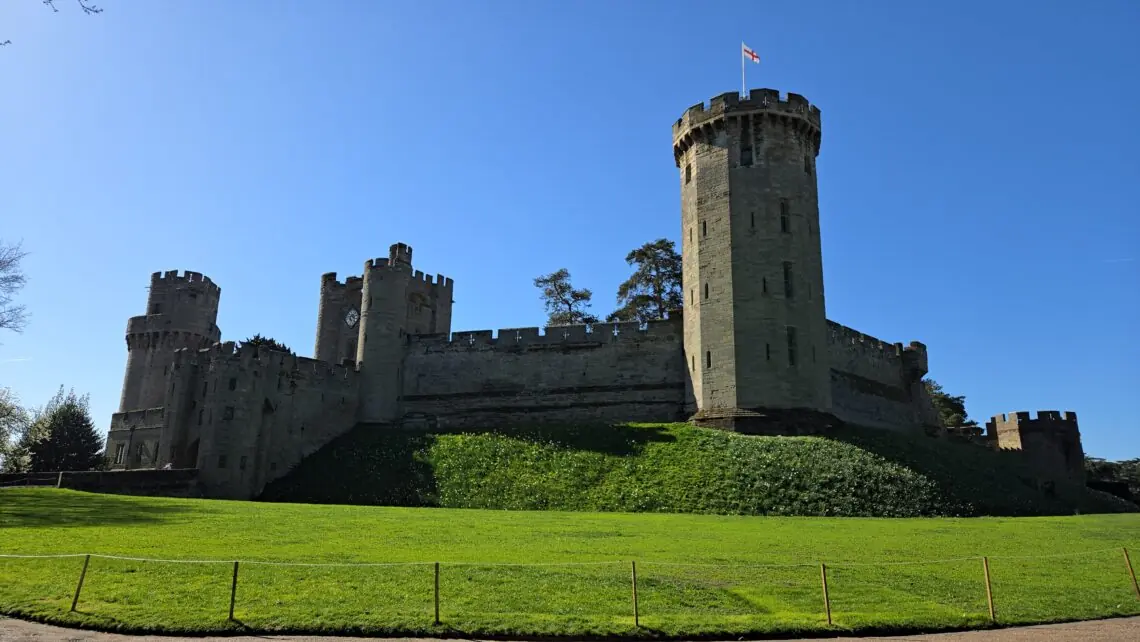Warwick Castle wasn’t originally on my must-see list—but I’m so glad we made the stop. We visited in spring, on one of those rare English days where it doesn’t rain. The weather was beautiful, the grounds were gorgeous, and we had an absolute blast. This one has quickly climbed the ranks to become a top sight of our trip.
I originally had hesitations. I’d read that it leans heavily into entertainment, and I wasn’t sure if it would feel too theme-parky for us. But to my surprise, it struck a great balance. Yes, it’s interactive and full of kid-friendly energy, but it’s still a real castle with important history. The museum side is there, just delivered in an engaging way.
If you’re planning a trip through England, you’ll quickly realize you can’t do everything. But, Warwick Castle earns its spot.
Warwick Castle Location
Wait, Is This the Right Way?
Driving into Warwick, I had a moment of doubt. The road led us straight into town and I started to wonder if I’d taken a wrong turn. I mean, aren’t castles supposed to be perched on lonely hills, far from coffee shops and traffic lights?
But sure enough, a well-marked sign pointed us off the main road, and suddenly we were winding through a quiet, leafy lane leading us to a big, grassy parking field.
We visited right at opening time, and while it wasn’t high season, the setup made it clear that Warwick Castle gets busy. Just beyond the lot, there were clean bathrooms (always a good start) and a shuttle stop for those who wanted a lift.
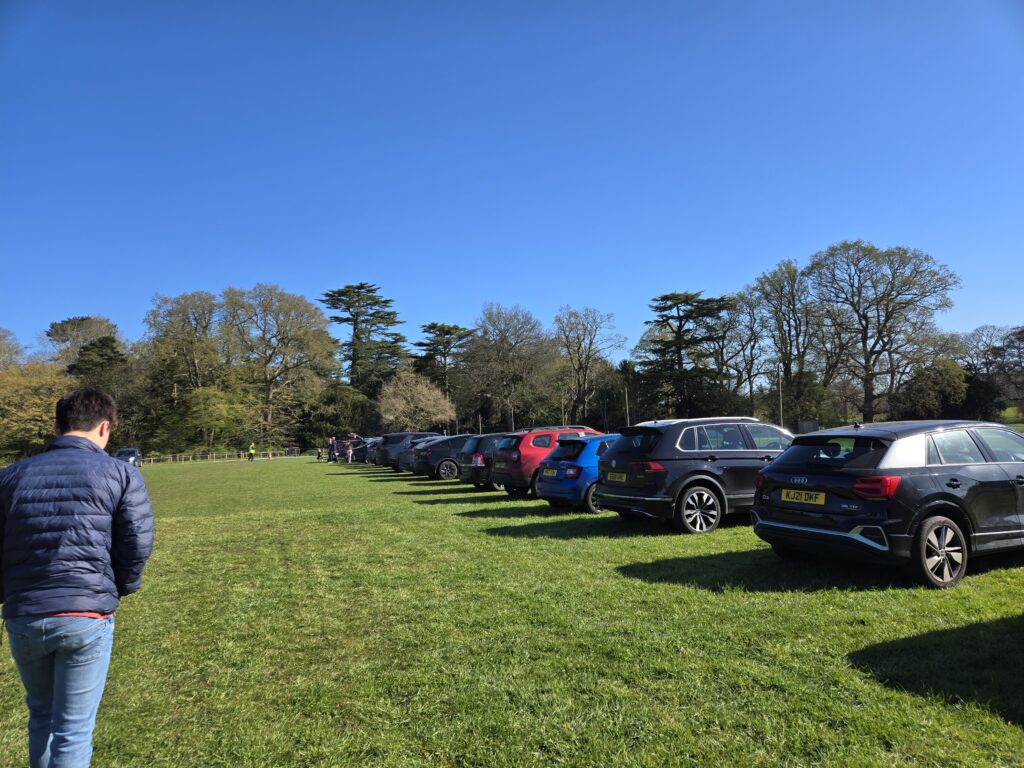
Photo Above: The parking lot at Warwick Castle. We were able to pay with a contactless card at exit, but there are also machines you can pay at near the castle entrance (but not at the parking lot that I could see).
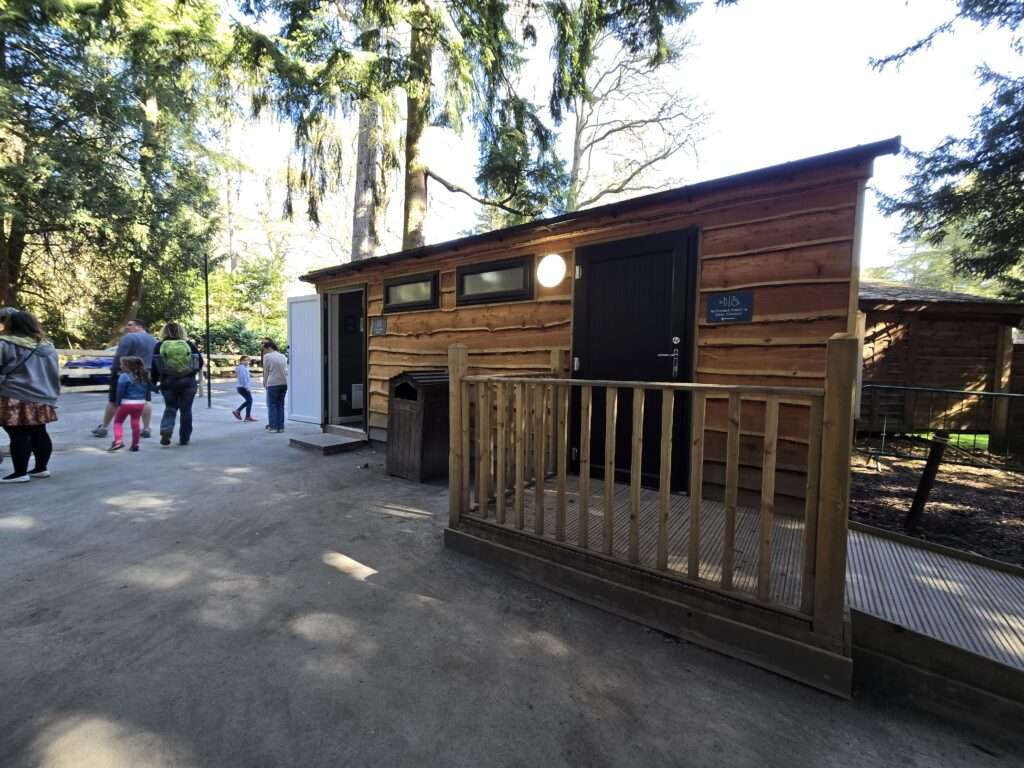
Photo Above: The bathrooms near the parking lot at Warwick Castle.
Approaching the Castle Through the Knight's Village
There was a shuttle running every 15 minutes when we visited, and a line had already started to form—mostly families with little kids. We opted to walk instead, which turned out to be a great choice.
Technically, the walk is listed as about 20 minutes, but it felt much shorter. Maybe that time accounts for crowds, or small feet? For us, it was an easy, flat stroll on a paved path. We crossed another parking area or two, and passed through a quiet lane to the castle’s front door.
Along the way, we passed the Knight’s Village—Warwick Castle’s on-site lodging area, complete with Woodland Lodges, Warwick Castle Hotel, and medieval-themed glamping tents nestled among the trees. We also passed the Knight’s Table, a themed restaurant, situated between the general parking lot and the castle entrance. We visited as a day trip but if we were to return, I would want to include an overnight stay in one of the castle’s integrated suites found in the castle towers!

Photo Above: The Lodge, a cozy place to stay while visiting this action packed castle.
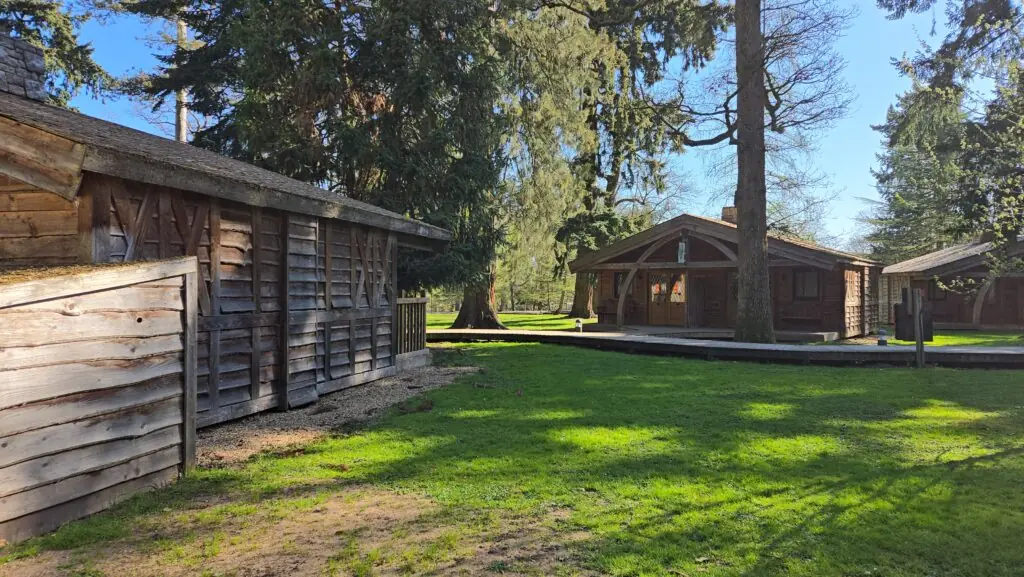
Photo Above: Cabins and glamping tents await tired visitors for an afternoon siesta or a themed night.
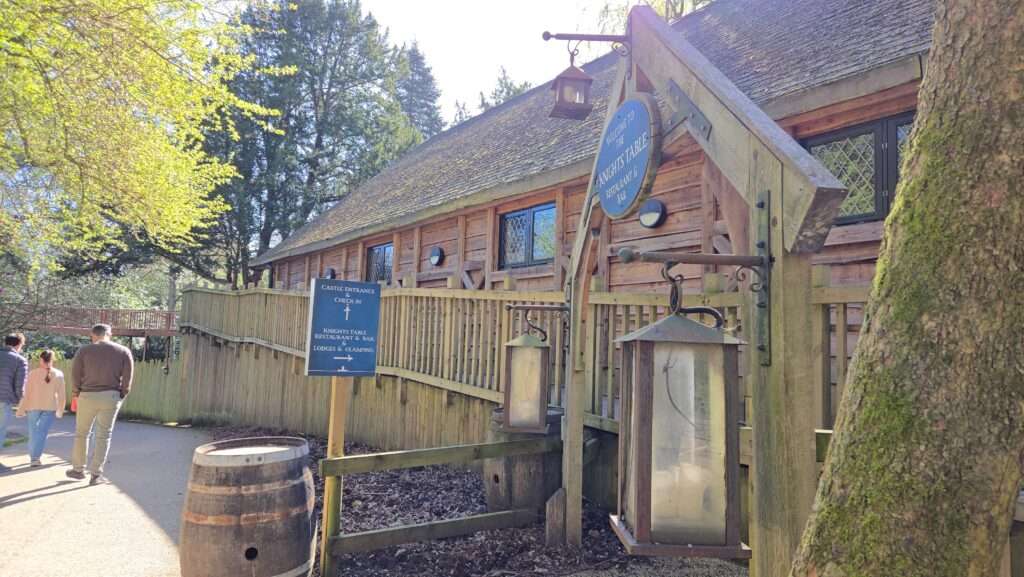
Photo Above: The Knight’s Table restaurant, located outside the gated attraction.
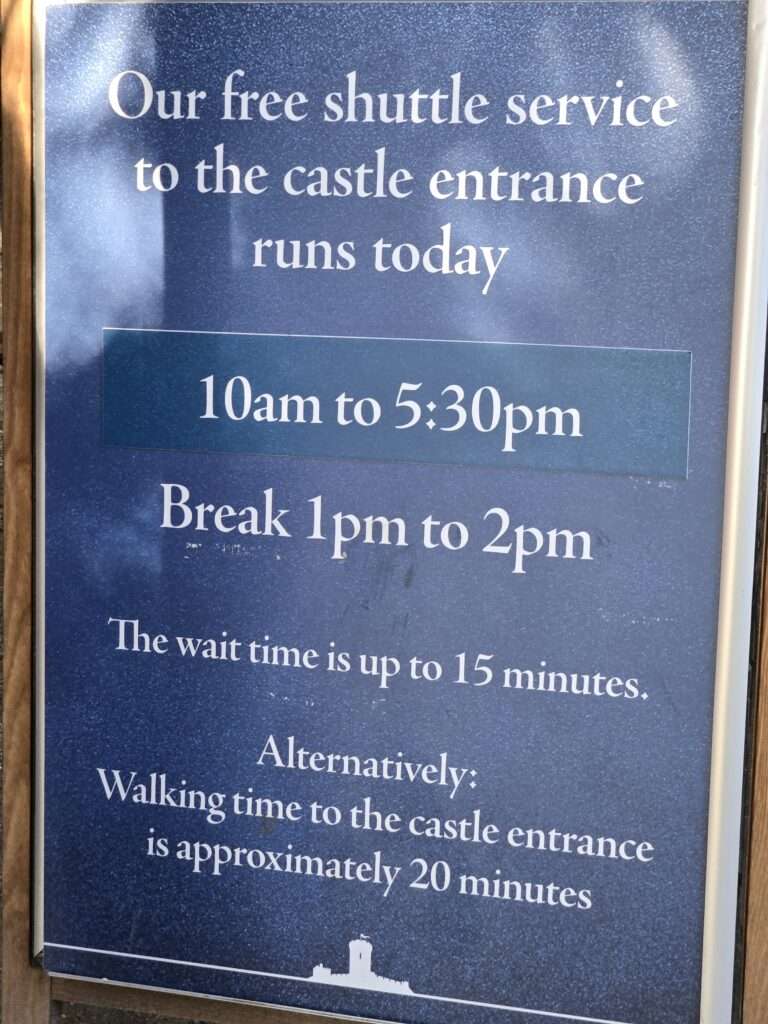
Photos: There is a sign marking the shuttle bus stop with information on frequency and times. Photo below shows the private path as you get close to the castle.
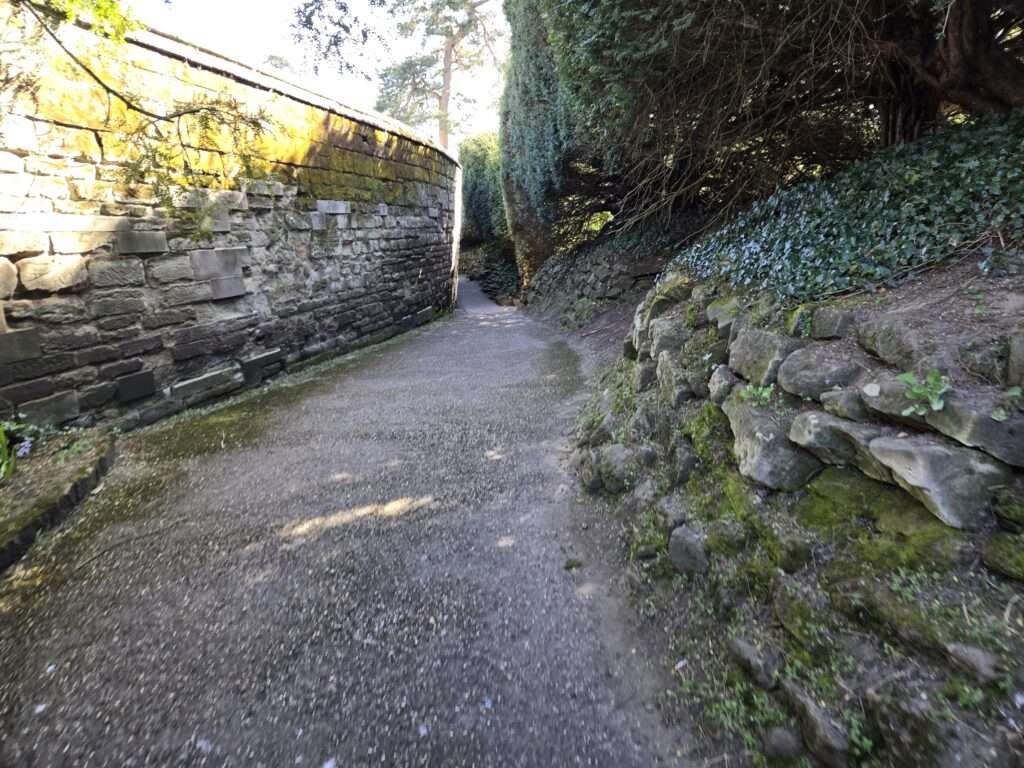
A Medieval Welcome
As we neared the castle entrance, we were greeted by staff dressed in full period costume like we’d stepped right into the 14th century.
We stopped for a quick photo and just as I lowered my phone, one of them raised an eyebrow and said, completely straight-faced, “That was quick. Most portraits take hours. Days, even.” They were in utter disbelief. And I realized I had traveled back in time.
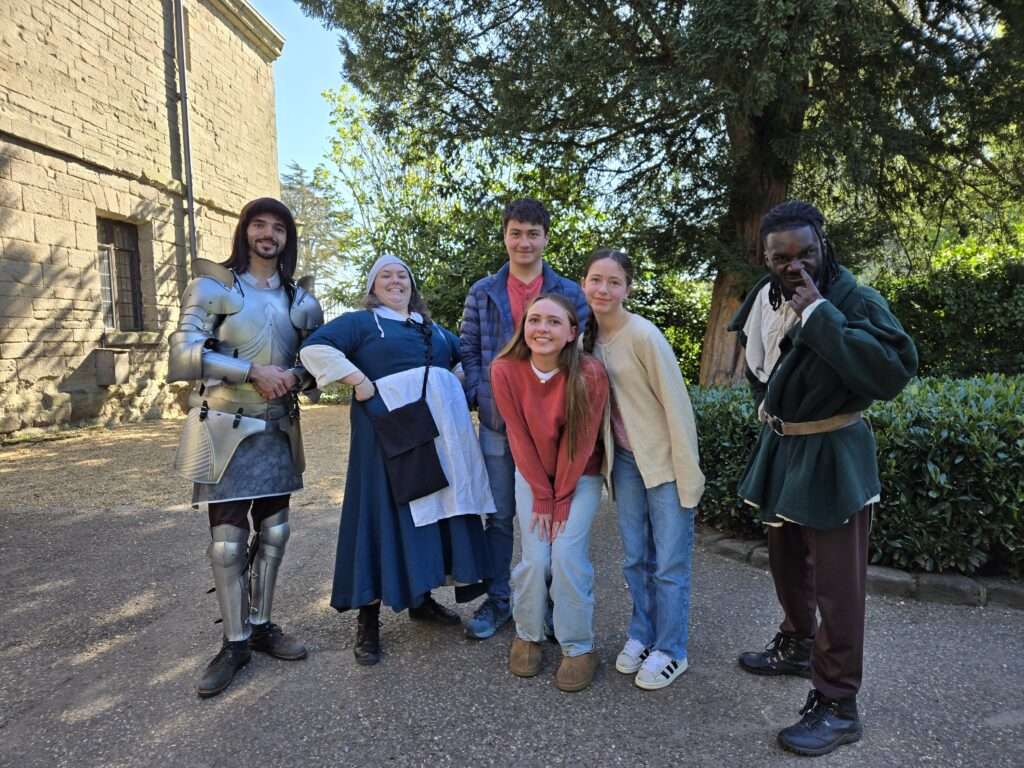
Photo Above: My kids pose with costumed staff stuck in the middle ages.
Heads up! This post contains affiliate links, which means I may earn a small commission if you make a purchase (at no extra cost to you). Your clicks help keep these posts going — for all the dreamers, travelers, and memory-makers out there.
Dragon Adventures for Younger Visitors
It didn’t take long to realize that Warwick Castle is designed with families in mind. One of the standout features for kids—especially the younger crowd—is its dragon-themed fun, built around Zog, the friendly dragon from Julia Donaldson and Axel Scheffler’s much-loved books. If you are visiting with kids, you might want to read one of the books in advance to introduce the character. Or to keep as a souvenir.
During our visit, we spotted a cheerful dragon statue perfect for a photo op (Ava couldn’t resist). And while our kids were a bit older for the activity trail, I could see how much fun it would be for younger children—especially those who aren’t always enthusiastic about “museums” or historical sites. If we’d visited a few years earlier, this kind of playful, story-driven experience would have been the perfect hook for my kiddos.
Zog and the Quest for the Golden Star is an interactive trail running from spring through late September. Kids complete five playful activities (like flying, roaring, and princess-saving), collecting stamps along the way before meeting Zog himself for a golden star and photo.
There’s also Zog Playland, with a dragon zip line, Princess Pearl’s Tower, and sand play areas—all inspired by Zog and the Flying Doctors. It’s all inclusive and thoughtfully designed, with the kind of creative energy that helps history come alive for kids without them even realizing it.
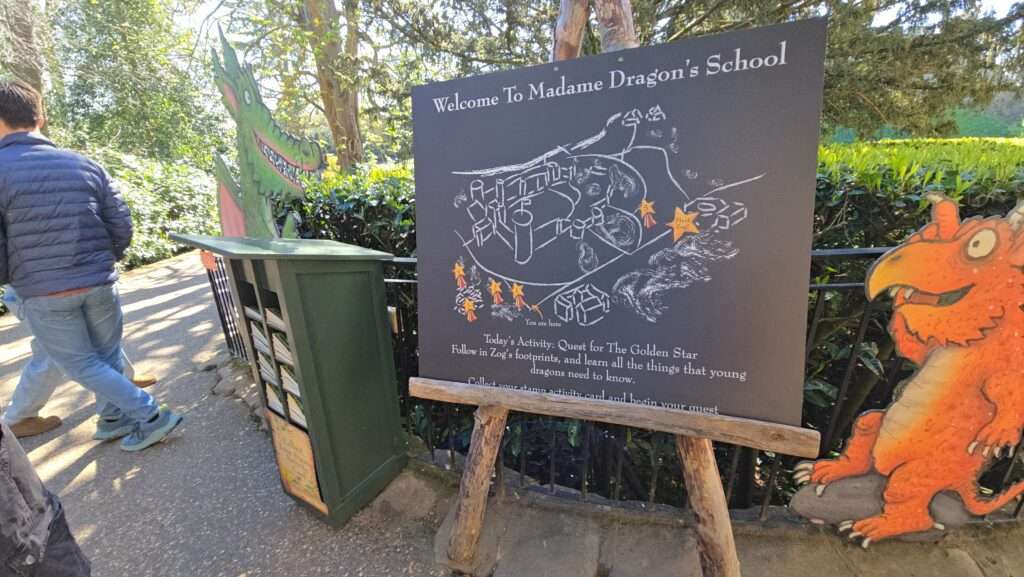
Photo Above: Visitors will learn about Zog and Dragon School, soon after entering. And this is also the first photo-op we noticed, with Zog. Ava agreed to a photo.
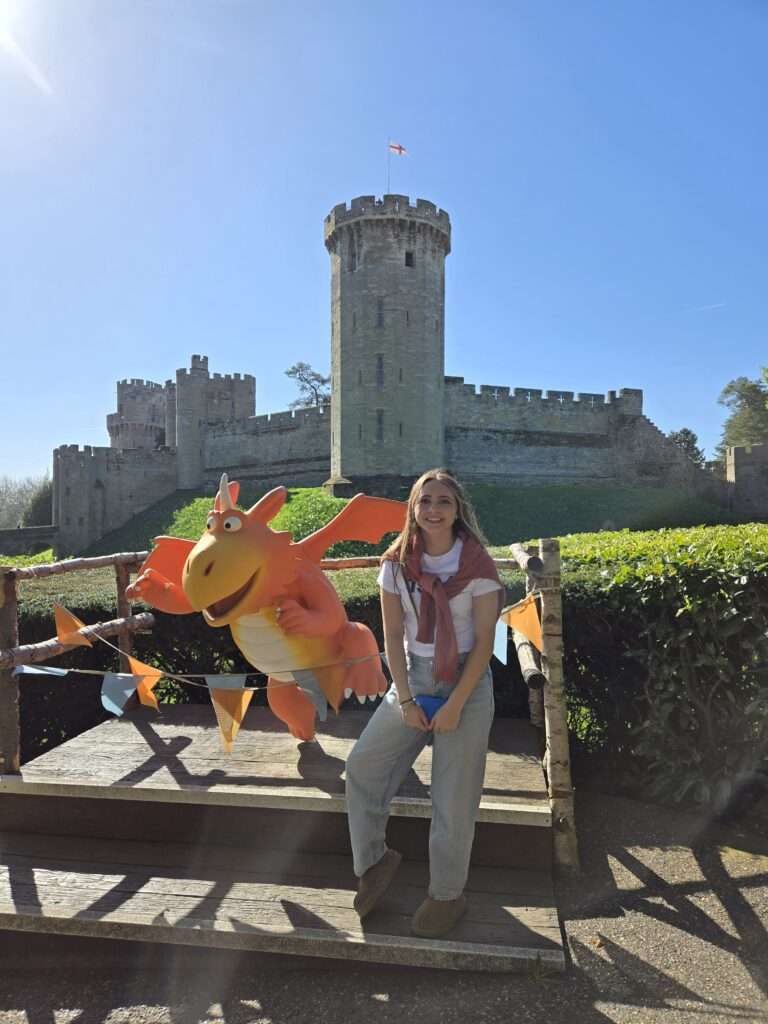
A Maze of Horrible Histories
No little kids? No problem. Just after learning about Zog, we stumbled upon the castle’s maze—and I’m here to tell you: this is fun for everyone.
I wasn’t expecting much. I figured it would be a simple garden maze, maybe a few hedges, a quick detour before the “real” history started. But this maze was cleverly designed for both kids and adults, with just the right mix of silliness and smarts.
Inside, we found clues to solve, fun challenges, and even a few obstacles to navigate—enough to keep everyone on their toes. Along the way, there were historical tidbits tucked into the experience: real facts, but presented in a way that actually made us want to stop and read them.
There were also unexpected photo ops and laugh-out-loud moments that made it feel more like an adventure than a detour. Technically, the goal is to find your way out—but we weren’t in any hurry. The fun was in finding the next surprise.
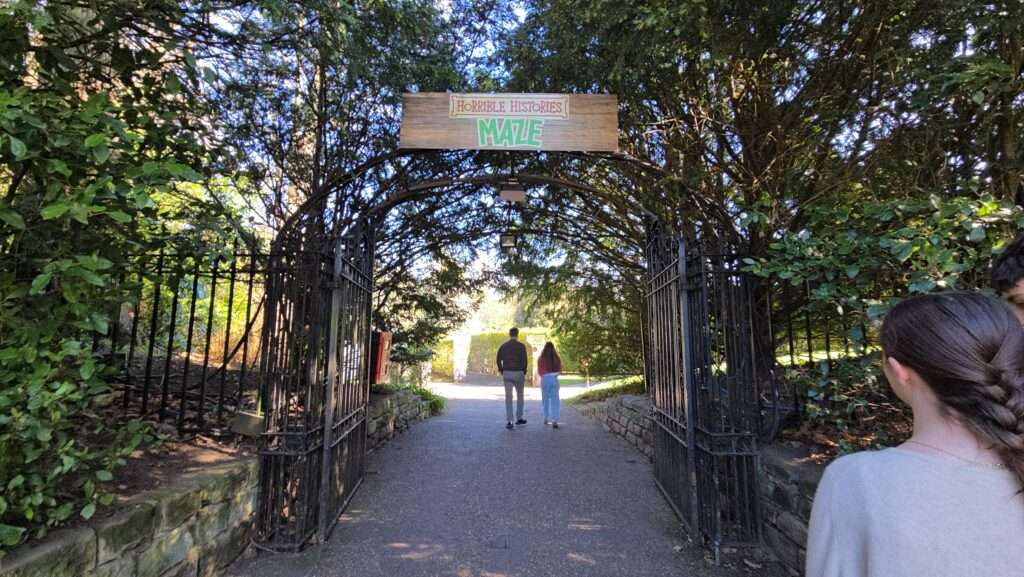
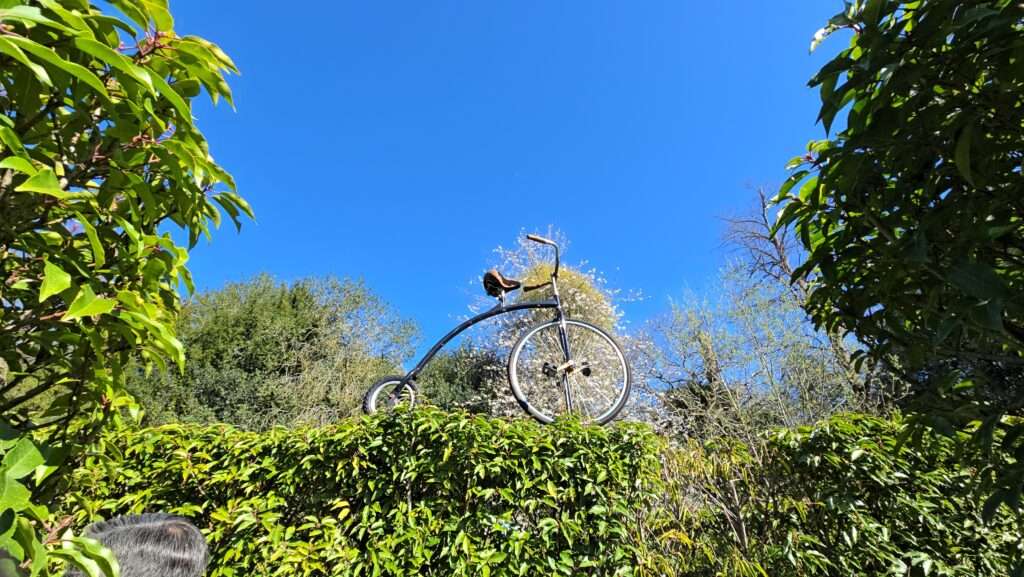
Photo Above: A trick on top of a maze wall – just a little decor that should pique curiosity as this is no ordinary maze.
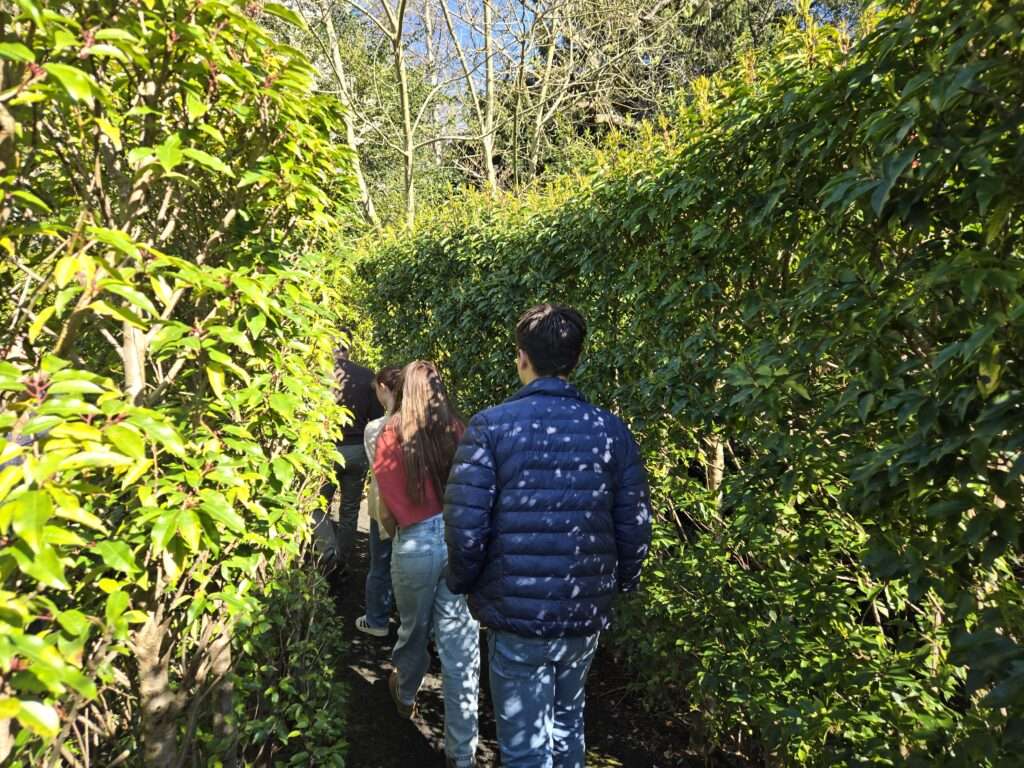
Photo Above: This is what the maze looks like inside.
Interactive Stations in the Maze
One station featured the stocks and pillory, used back in the day even for minor crimes. Visitors could pose inside for a photo (we did, of course). We could imagine what it might have felt like to be publicly shamed for stealing a loaf of bread or gossiping too loudly.
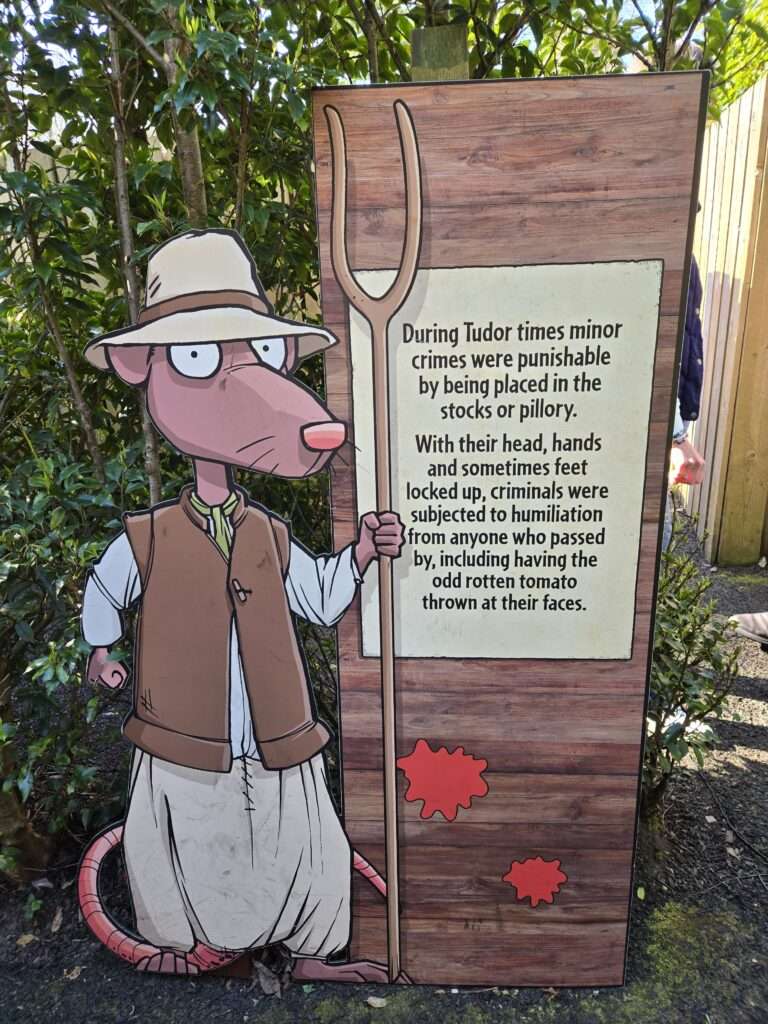

Photo Above: My girls imagining what it must’ve been like during Tutor times. Yikes!
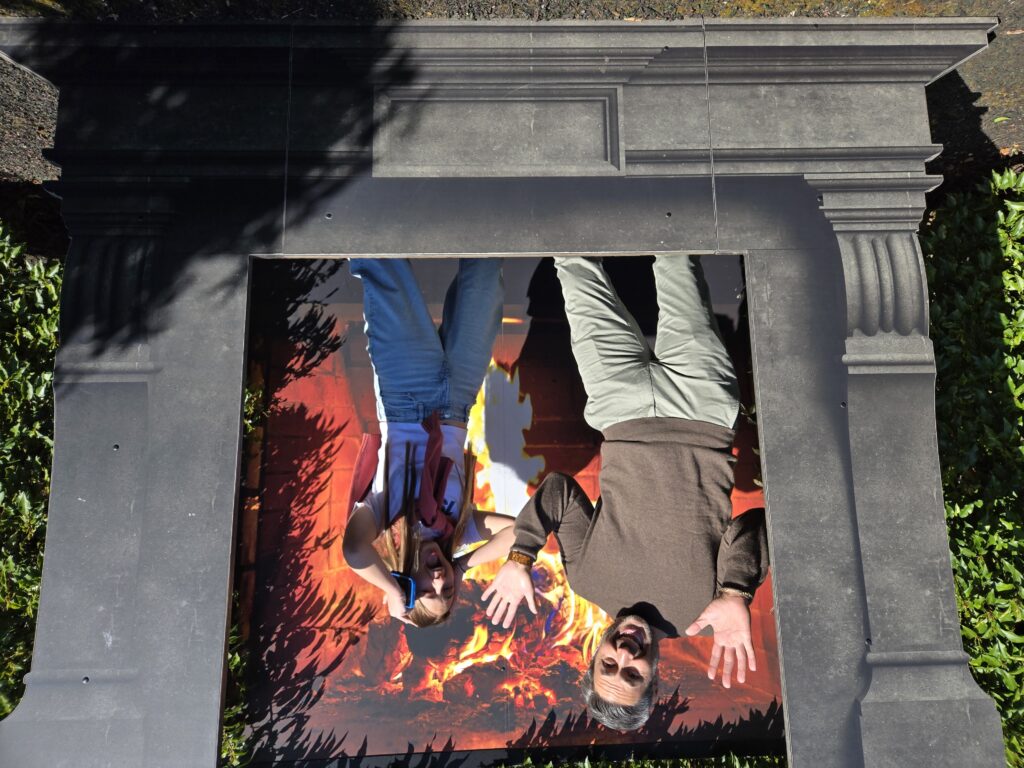
Photo Above: Another opportunity to interact with a station – here Gary and Ava find themselves hanging upside down in a fireplace.
Choose Your Exit out of the Maze
And just when we thought we’d seen it all, we reached the exit—where, in true Warwick fashion, there was one final surprise. The maze splits: one exit route for adults and another for children. It’s a small detail, but it says a lot about how well thought-out the whole experience is. Even the exit strategy is tailored, making sure every visitor—regardless of age or energy level—finishes strong.
This wasn’t just a maze. It was a genuinely clever, engaging, history-wrapped experience that we were still talking about hours later. If you’ve got kids, they’ll love it. If you don’t? You’ll probably still love it.

The Maze to the Castle
When we finally exited the maze, I was genuinely surprised to find we’d arrived right at the entrance to the castle itself. Somewhere along the winding paths, obstacles, and quirky history lessons, I’d completely lost my sense of direction. I think I expected to pop out near where we started—but nope. The maze had quietly carried us forward, and now we were right where we needed to be.
Just before entering the castle, we were offered a photo opportunity by one of the staff members. Warwick Castle offers a photo pass, which you can purchase in advance or on-site. Throughout the grounds, staff are stationed at key spots to help you capture family photos (with everyone in the shot—a rare feat if you’re usually the one behind the camera). We didn’t purchase the pass, since not everyone in our crew is a fan of staged photos, but it’s a great option if you’re hoping to collect memories without juggling your phone the whole day.
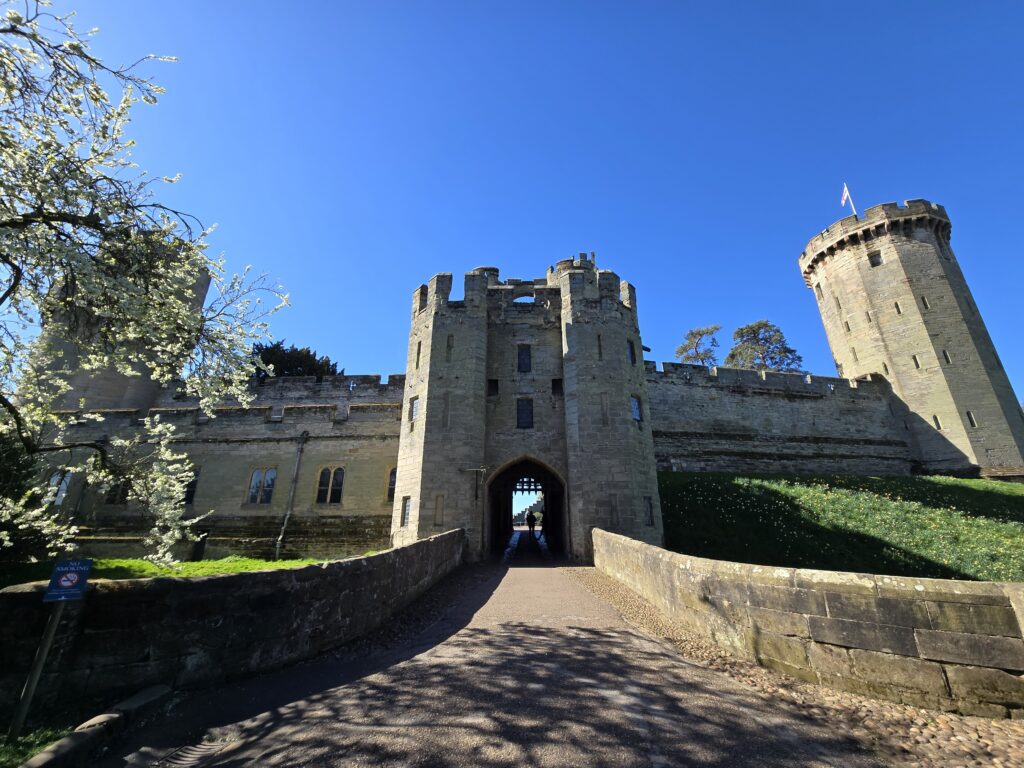
Photo Above: The entrance to the castle, where you exit the maze.

Photo Above: A view from the inner courtyard inside the castle.
So Much to Do and See at Warwick Castle
I think is is where I need to give a heads up. Warwick Castle offers a remarkable range of attractions, blending historical storytelling with just the right amount of theatrical flair. It’s not the kind of place where you quietly shuffle from room to room—there’s truly something for everyone, from immersive exhibits to live shows and hands-on adventures. This is an experience, and it is going to fill up your day – maybe even more.
Inside the castle, you’ll find beautifully preserved spaces like the Great Hall and State Rooms, along with interactive experiences such as The Kingmaker, which drops you into the chaos and strategy of the Wars of the Roses, and The Royal Weekend Party, where Victorian high society is recreated in surprising detail. There’s also the Time Tower, a compact but cleverly designed multimedia history tour, and for younger guests, the fairytale-themed Princess Tower.
If you’re up for a scare, the Castle Dungeon delivers. Outside, the energy ramps up with crowd-favorite live shows like The Falconer’s Quest, featuring breathtaking aerial displays from over 60 birds of prey, and Wars of the Roses LIVE!, a full-scale jousting spectacle set against the backdrop of the castle walls. There are also demos like The Bowman (learn to shoot like a medieval archer) and the Legend of the Trebuchet, where Britain’s largest working siege engine comes to life.
For families, Warwick goes all-in. There’s the Horrible Histories Maze, which we’ve just covered—it’s packed with fun, photo ops, and quirky historical facts. Younger kids can join Zog and the Quest for the Golden Star, an interactive trail based on the beloved children’s book, or let off steam in Zog Playland, a themed play area with a dragon zip line, Princess Pearl’s Tower, and sensory stations. Seasonal shows like the Zog Live Show and hands-on activities like Knight School round out the kid-friendly offerings.
Even the grounds are part of the experience. The Peacock Garden offers a scenic stroll (and a chance to spot some actual peacocks), and there are plenty of spots to recharge—like the Undercroft Café inside the castle or the Conservatory Tea House, which overlooks the gardens. For those staying overnight, the Knight’s Village offers glamping tents and woodland lodges, complete with evening entertainment and medieval-themed dining at The Knight’s Table.
There is so much to see, that I cannot cover everything in detail in this post. But, I think it is helpful to have a heads up, that the list is long and a visit requires a time investment to see everything on offer. On this aspect, it is like a theme park.
The Kingmaker: A Step Into the Past
The first attraction we visited inside the castle was The Kingmaker—and it completely caught me off guard, in the best way. I hadn’t read much about it ahead of time, so I wasn’t sure what to expect. What we walked into felt less like an exhibit and more like a portal. It was nothing like your typical museum display.
The experience tells the story of Richard Neville, the 16th Earl of Warwick—known as “The Kingmaker” for his role in the Wars of the Roses—and it does so through a fully immersive, walk-through scene that unfolds around you. From the moment we stepped inside, it was as if we’d been dropped into the middle of history-in-the-making. The lighting was dim and atmospheric, the soundscape rich and layered, with a voice narrating key events as the story unfolded room by room.
What really brought it to life were the detailed scenes: lifelike mannequins dressed in full costume, frozen in moments of daily life as the castle prepared for battle. Candlelight flickered against stone walls. You could hear horses being shod, soldiers gearing up, and the chatter of castle life echoing down the halls. It felt as if we were invisible guests—or time-traveling flies on the wall—watching the Earl’s household spring into action.
It was theatrical, yes, but thoughtfully done. Not flashy or overproduced. It respected the historical context while also keeping visitors of all ages engaged. It was a quiet standout for me, and not something I’ve seen done quite this way at other historic sites.
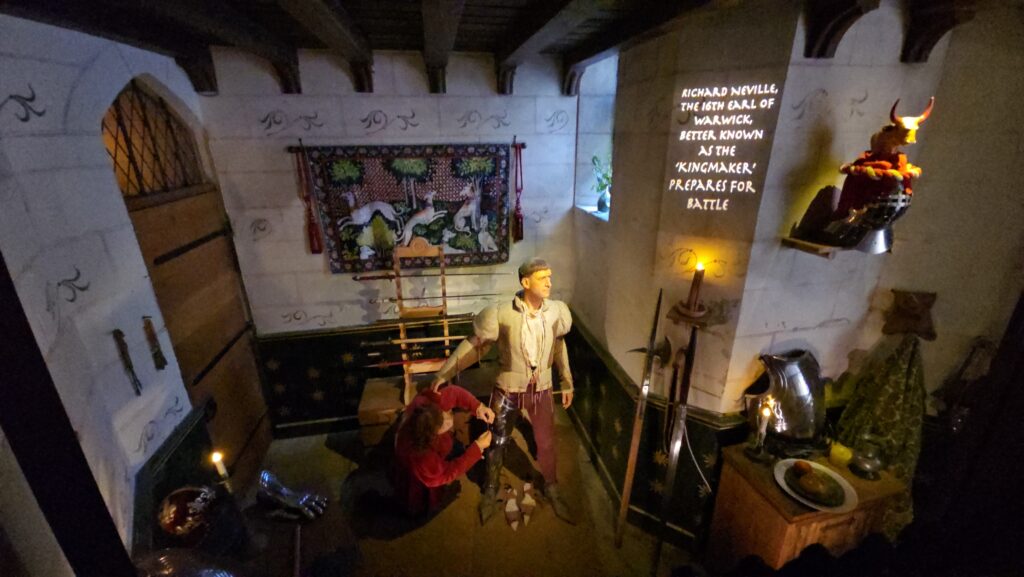
Photo Above: Visitors can read their way through each scene, as the story is displayed on the wall.
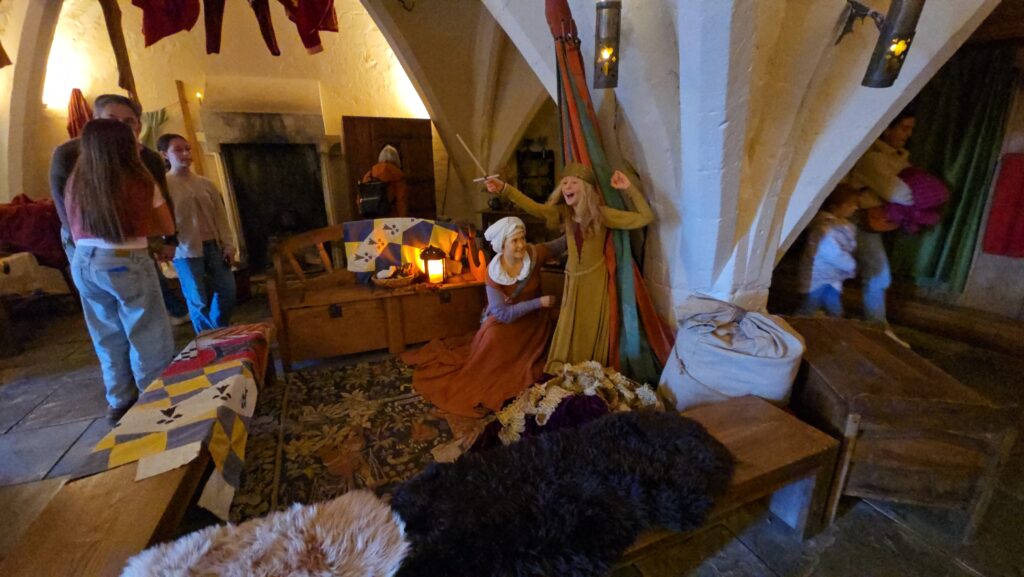
Photo Above: Much detail is shown in the lifelike reenactment by mannequins throughout the attraction.
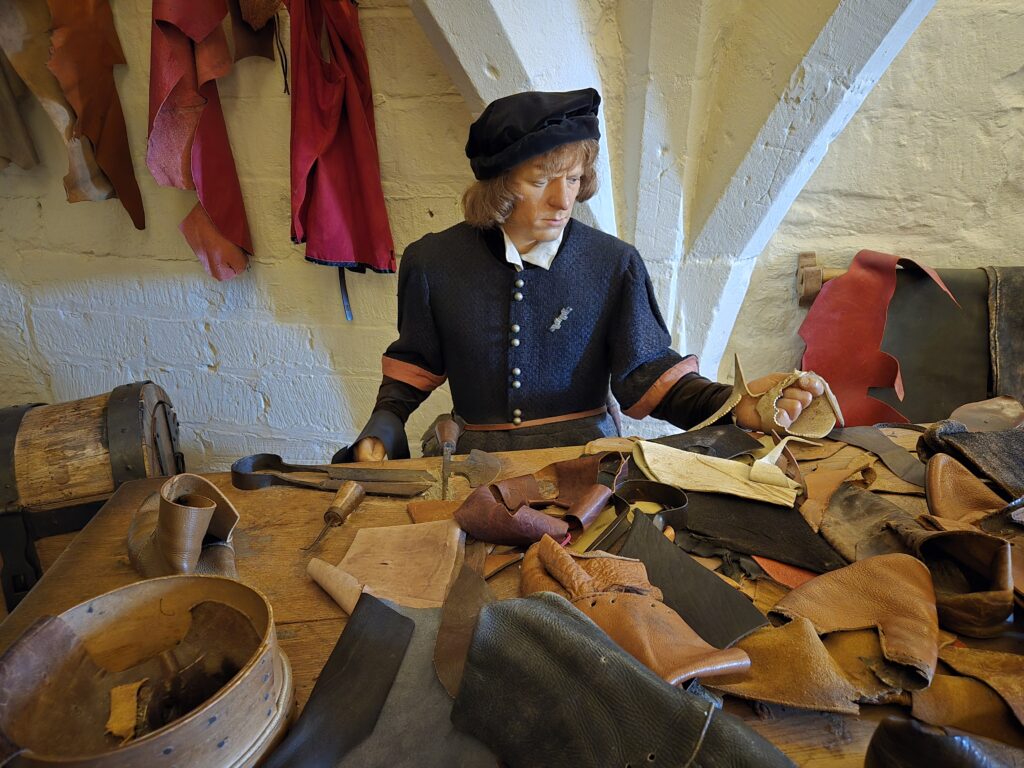
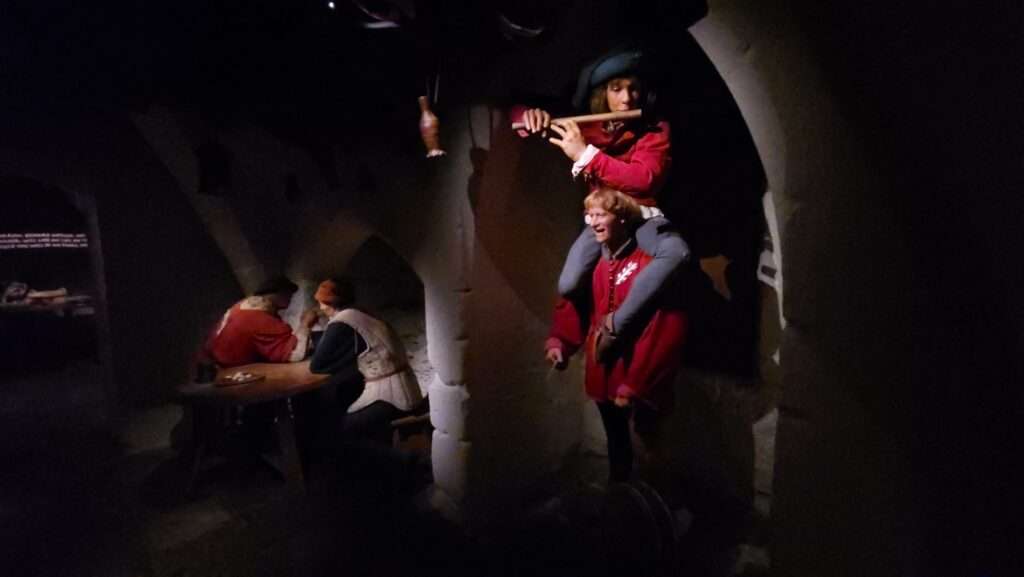
The Time Tower: History, But Make It Cool
After The Kingmaker, we made our way to the Time Tower, which turned out to be another standout. We had to wait for our turn to enter, and I assumed the short video we watched at the start was the attraction—just a little historical intro before moving on. But no. That was only the beginning.
Once the video set the stage, we were guided into a series of small chambers, each stopping point revealing more of the castle’s long and layered history. The storytelling wove through centuries, tracing the rise and fall of power in England, and always tying it back to the role Warwick Castle played.
The final room really surprised me. Along one wall were framed portraits—but instead of static paintings, these were digital displays. Characters from different time periods appeared inside the frames, interacting with each other across the centuries. They moved, spoke, reacted, and even crossed from one “portrait” to the next. It was theatrical, yes, but also clever, funny, and—somehow—emotionally resonant.
I’ve visited plenty of historic sites where the information is solid but the delivery… isn’t. The Time Tower took a different route. It made history approachable and genuinely entertaining—without watering it down. A little bit Hogwarts, a little bit BBC, and a very cool way to learn. I think it was at this point that I decided more historical sites should make more effort to engage its visitors, like they do here at Warwick.
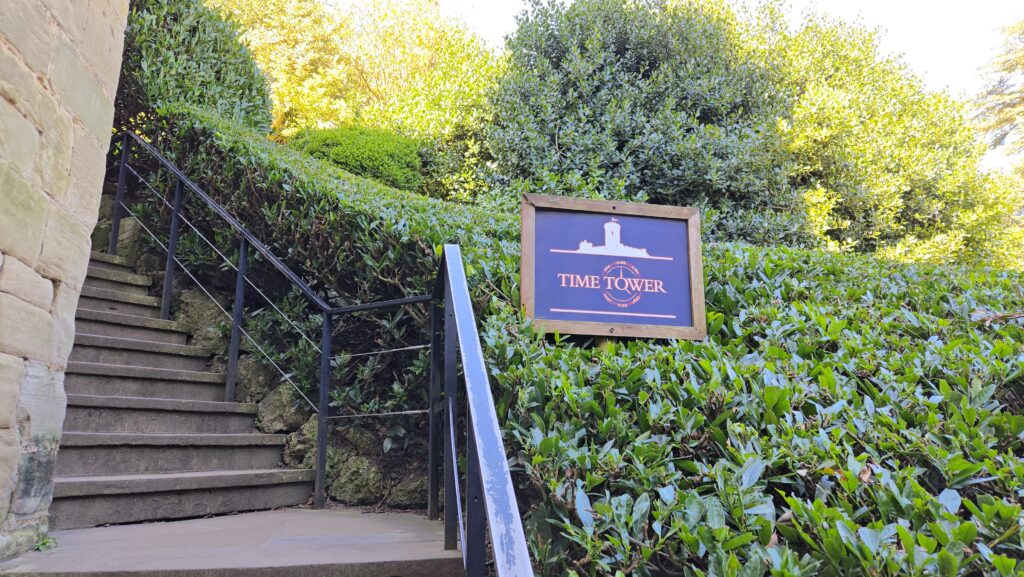
Photo Above: The climb to Time Tower.
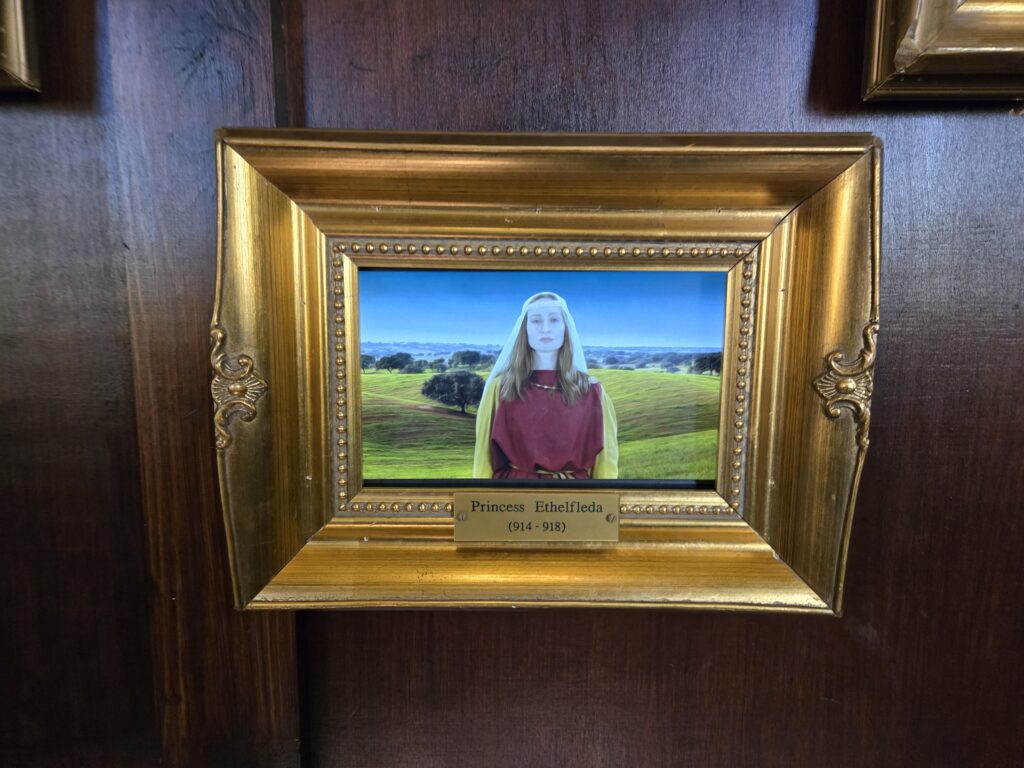
Photo Above: One of the talking paintings on the wall.
Towering Options (And Towering Stairs)
Warwick Castle has a lot of towers—and unlike some historic sites where certain areas are off-limits, behind velvet ropes, or hidden behind “staff only” signs, here it felt like everything was open. There wasn’t an extra fee, no gated doors, just free rein to explore. And we did—at least, some of us.
Each tower offered something a little different. The climbs varied in difficulty—some tight spiral staircases that had us hugging the stone walls, others broader or broken up by little landings. Not everyone in our group had the energy (or knees) to tackle them all, and that was fine. There were plenty to choose from, and no pressure to do everything.
What surprised me was how connected the towers were. You could climb up one, cross along the ramparts, and descend from another—essentially making a loop. This was a fun way to explore, but also something to note if your group splits up: the exit might not be where you started.
The views were, as you’d expect, fantastic. From one side, we could see down into the castle grounds, with people moving between shows and picnic tables. And from another? A picture-perfect view of Warwick Cathedral, rising above the town’s rooftops.
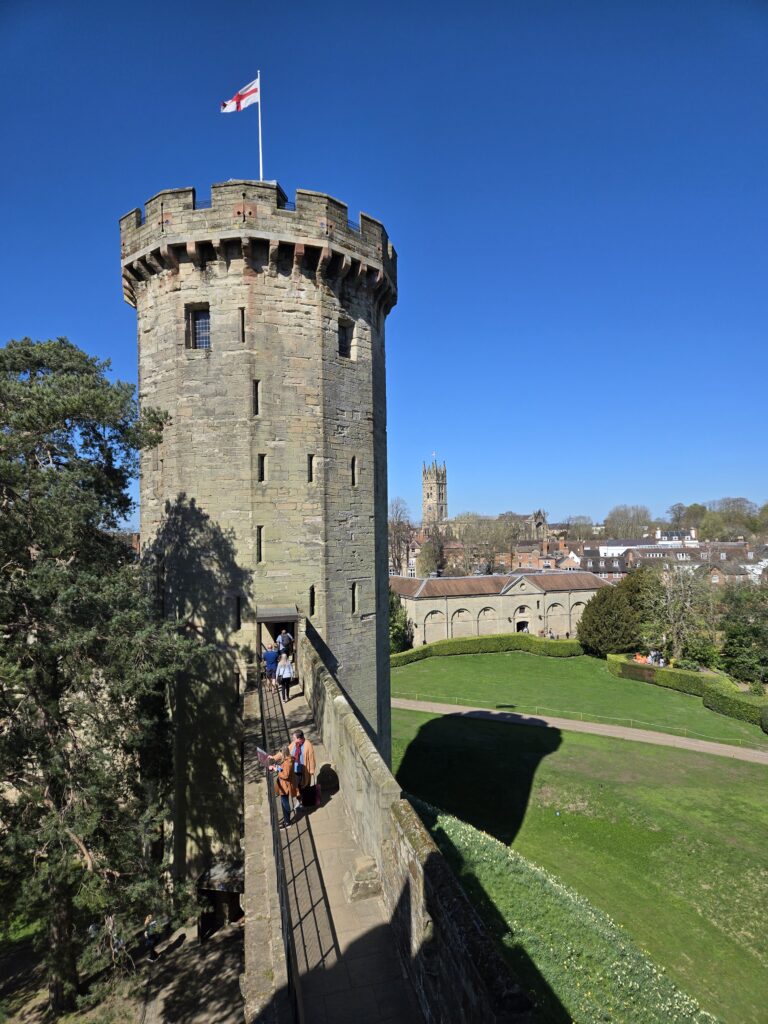
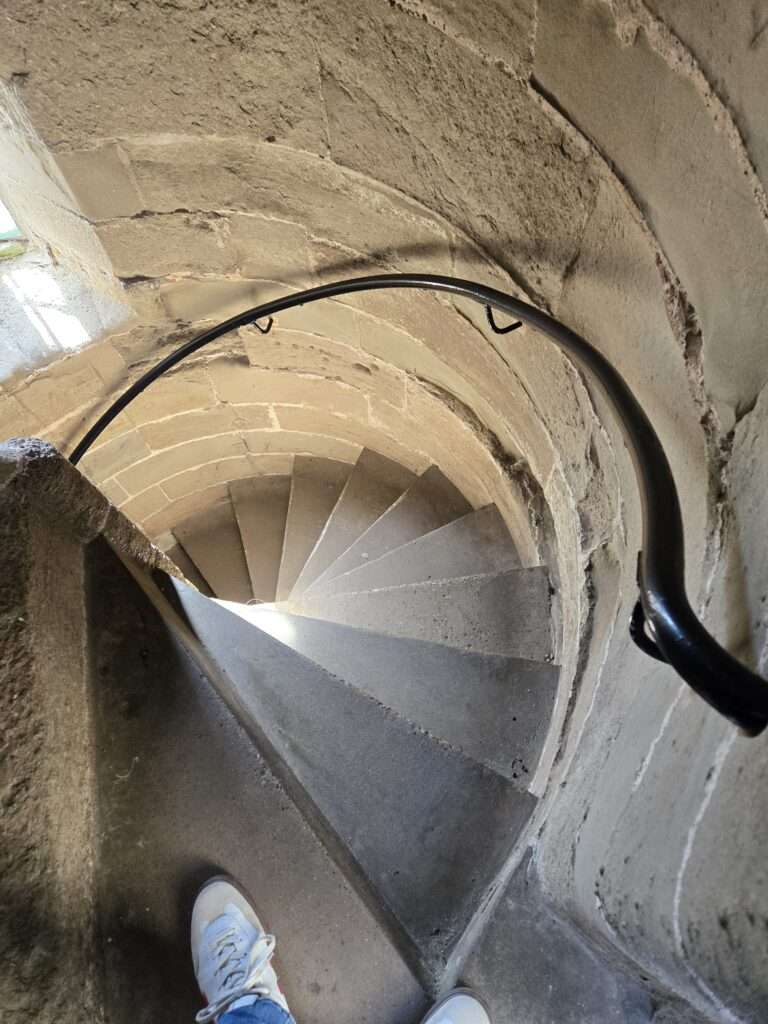
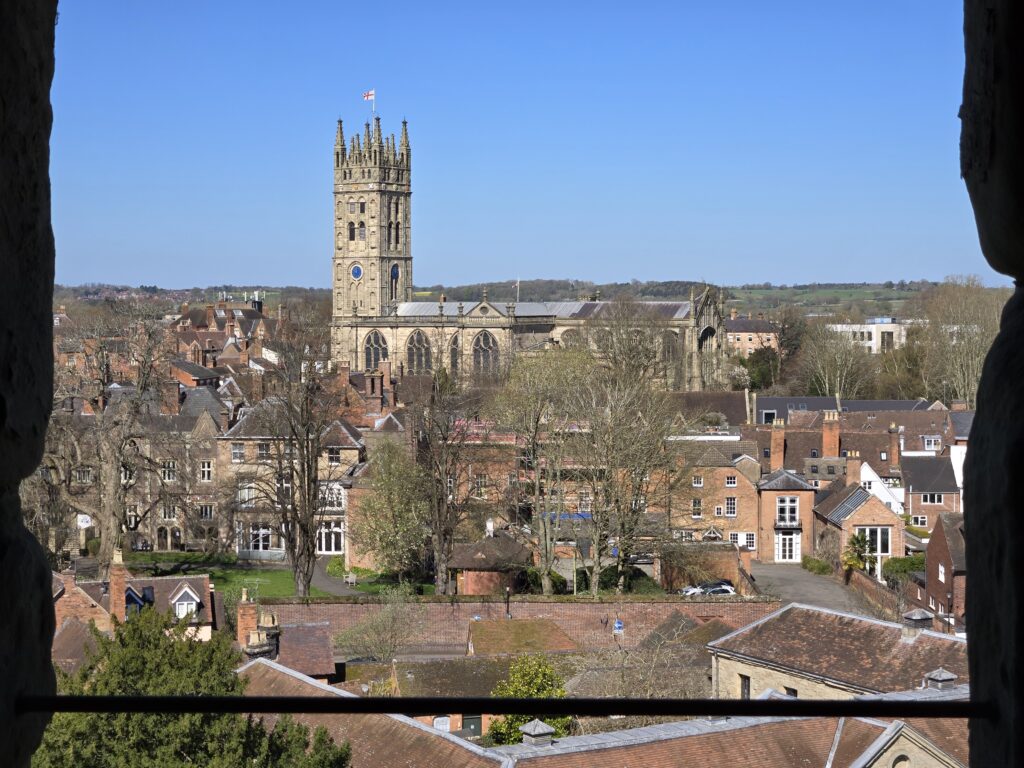
From the Towers to the Dungeon
From the heights of the towers to the depths of the dungeon, Warwick Castle gives you the full vertical experience. While some of us stayed up top, soaking in the sunshine and cathedral views, a few of us ventured down into the Gaol—the original medieval prison beneath the castle.
And let me tell you: it was a stark shift.
The space was dark, damp, and uncomfortably cold—the kind of cold that settles into your shoulders. It smelled of stone and time, and the air felt thick, like it hadn’t moved in centuries. There were no actors, no sound effects, no interactive elements here. Just low ceilings, heavy shadows, and a few simple signs on the walls, describing the lives (and fates) of the people once held down there.
It wasn’t dramatic, and it didn’t need to be. That absence of storytelling made it feel even more unsettling—your imagination did the heavy lifting. And while most castle attractions are built to entertain, this one reminded us that parts of Warwick’s history were anything but fun.
Let’s just say, no one would have gone down there by choice back then. And even now? I didn’t linger.
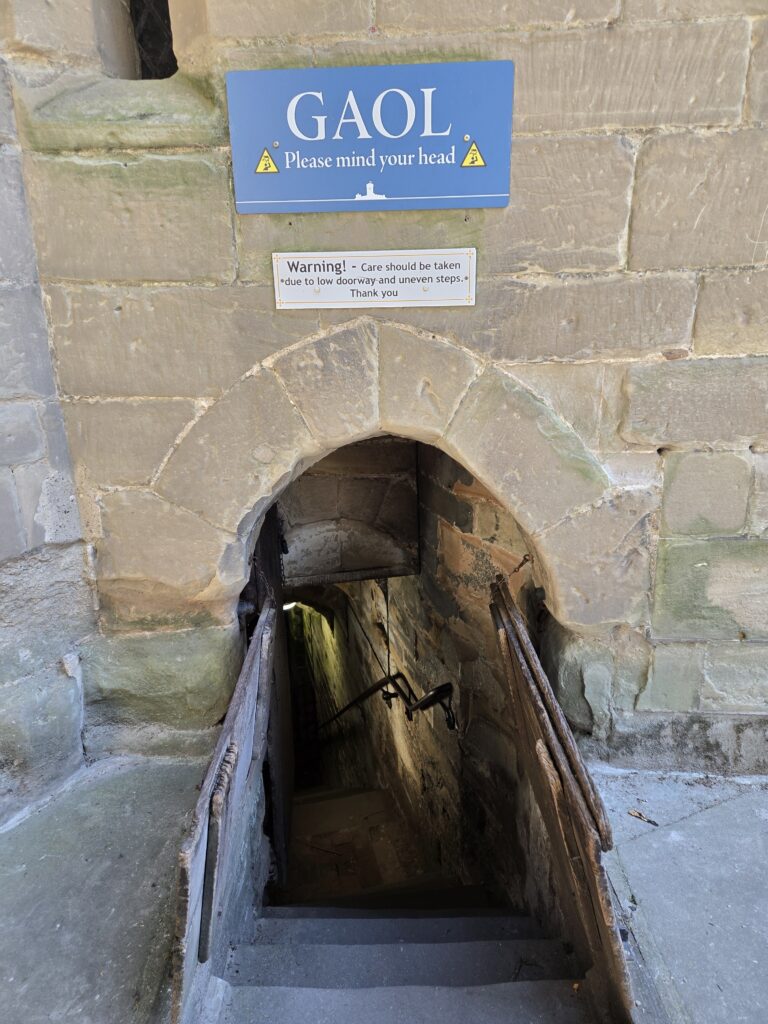
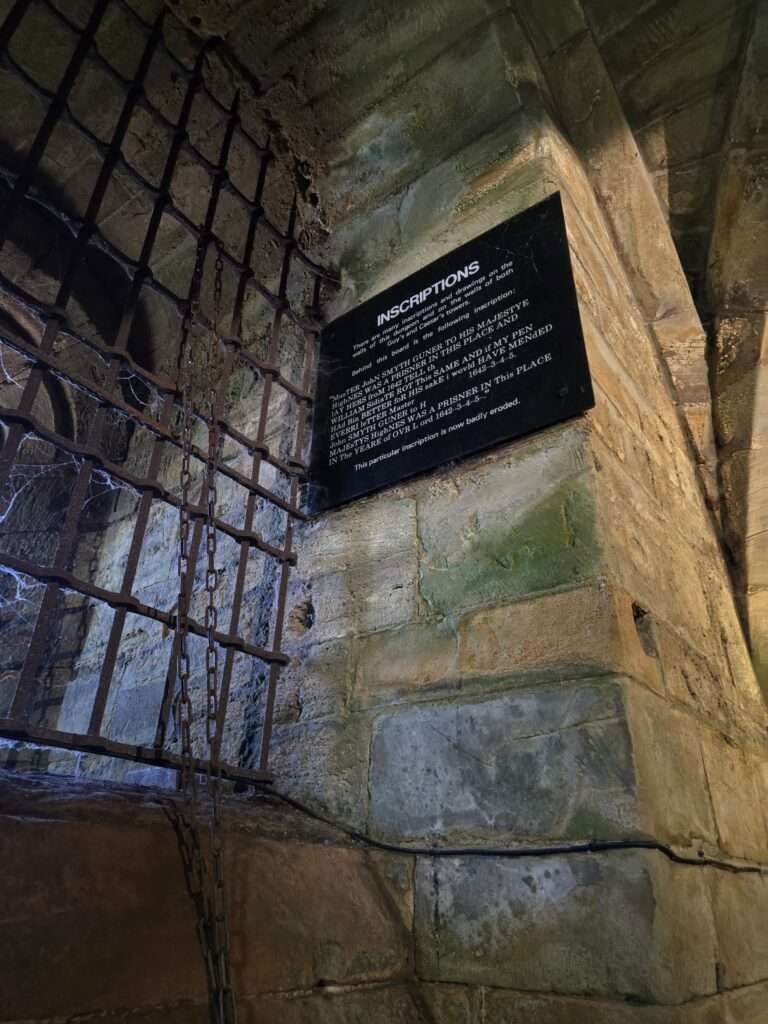
The Conqueror’s Fortress: A Quiet Climb Through Time
After the buzz of the towers and the chill of the Gaol, we found ourselves drawn to a quieter corner of the castle grounds: The Conqueror’s Fortress. Also known as The Mound, it’s the oldest part of Warwick Castle, originally built in 1068 under the orders of William the Conqueror.
The climb was more of a gradual incline than a steep staircase—an easy, pleasant ascent. Along the way, interactive signage walked us through the history of the site, each one adding another layer to the story. It was a thoughtful pause in the day—part learning, part leg-stretching, part peaceful moment.
At the top, we were rewarded with a lovely view over the River Avon and the green expanse below. From that height, we could even spot the Falconer’s Quest show setting up in the distance. It was a relaxing perch—quiet, scenic, and a great place to take it all in before heading back into the bustle of the castle grounds.
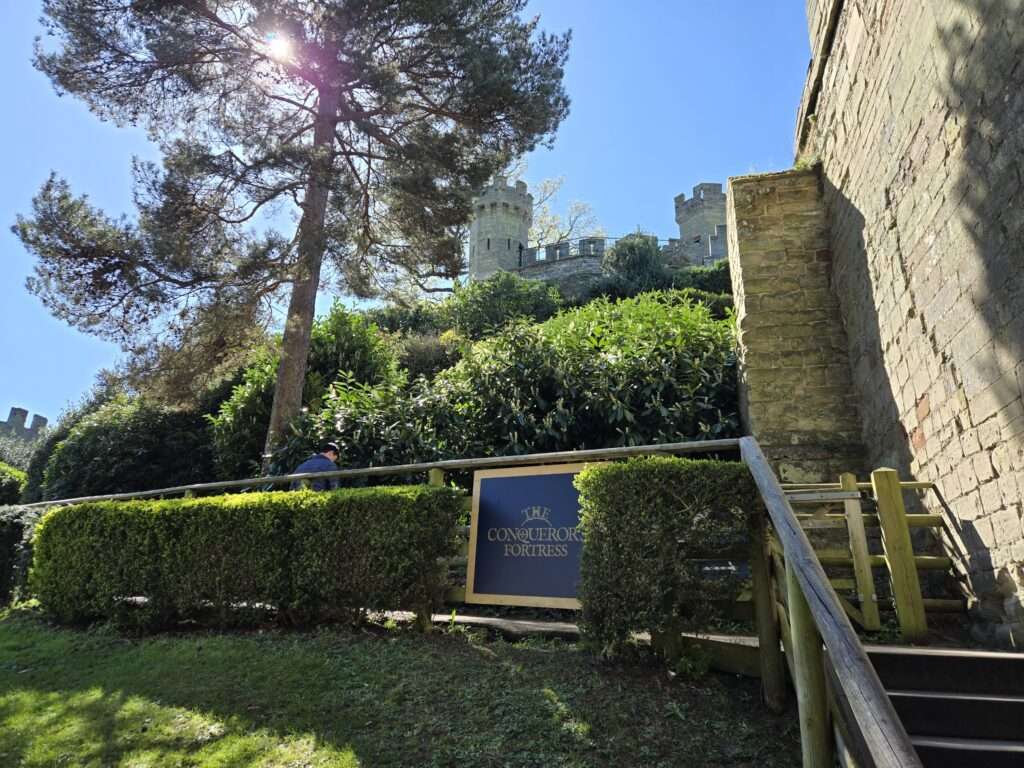
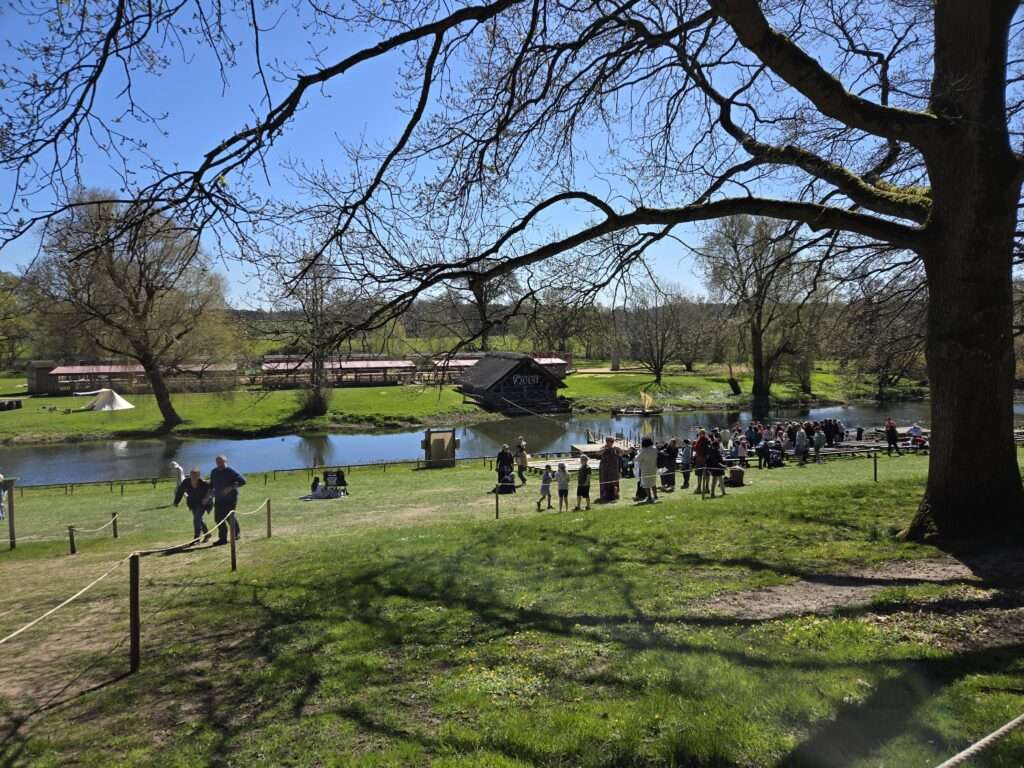
Around the Grounds (and a Note on Food)
As we continued exploring the castle grounds—still within the paid area—we found even more to see and do. There was the stage for the Falconer’s Quest (be sure to check the time and plan accordingly), archery demonstrations (and a chance to try it out for an additional fee), a children’s play area, a small performance stage geared toward kids, and several food stands scattered throughout. It really was set up like a full-day destination, not just a quick stop for castle history. I’m pretty sure I even saw kids learning a dance in the middle of a lawn.
Now, about the food.
We hadn’t originally planned to eat there, but the day stretched longer than expected (there’s more to see than you think!), and hunger eventually caught up to us. Unfortunately, this was the one letdown of our visit. In my opinion, the food was expensive—and not very good. We tried the pizza, which was passable if you kept your expectations low, and a baked potato with chili and cheese (apparently a classic in England), which I’d put firmly in the “we ate it because we needed to” category.
The only one who seemed genuinely interested in the food was a nearby peacock, who decided Gary’s lunch looked far better than it tasted. What followed was an unexpectedly dramatic stand-off between bird and human—which the rest of us found wildly entertaining. Gary? Less so. I happen to love peacocks, so I would’ve gladly sacrificed my sad potato situation if it meant luring one closer to our table. Gary, not so much.
That said, drinks were fine (hard to mess up beer and soda), and I did spot several picnic areas that I wish we’d taken advantage of. If you’re planning ahead, I’d definitely recommend bringing your own lunch for a safe bet. It’s not something I say often, but in this case, it would have been the better choice.
Still, food aside, everything else about the day—from the shows to the views to the immersive storytelling—was genuinely well done.
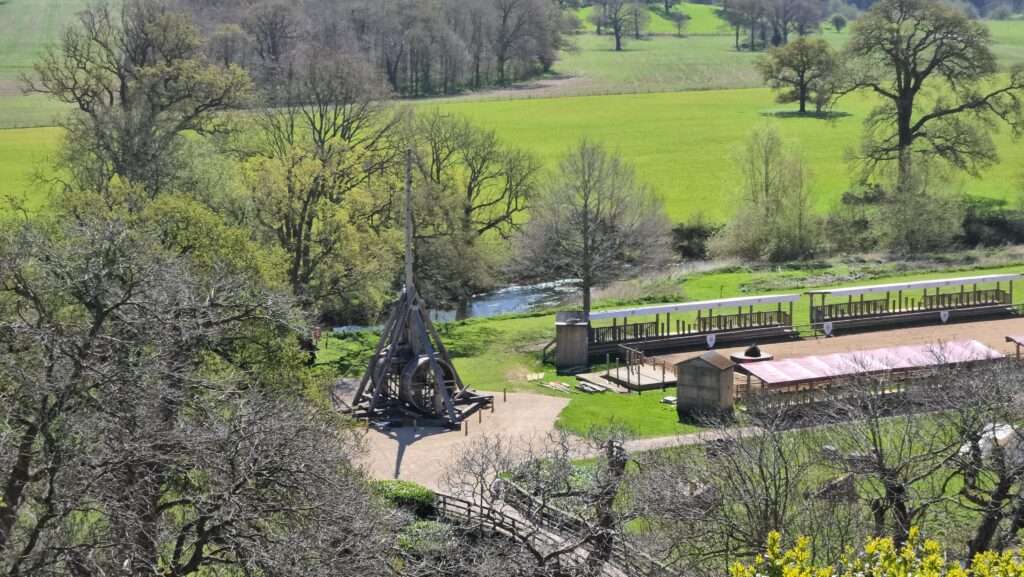
Photo Above: The catapult appeared to be out of order while we visited, but we could still see it. It just wasn’t being shown off. Still cool though, as I had never seen one before.
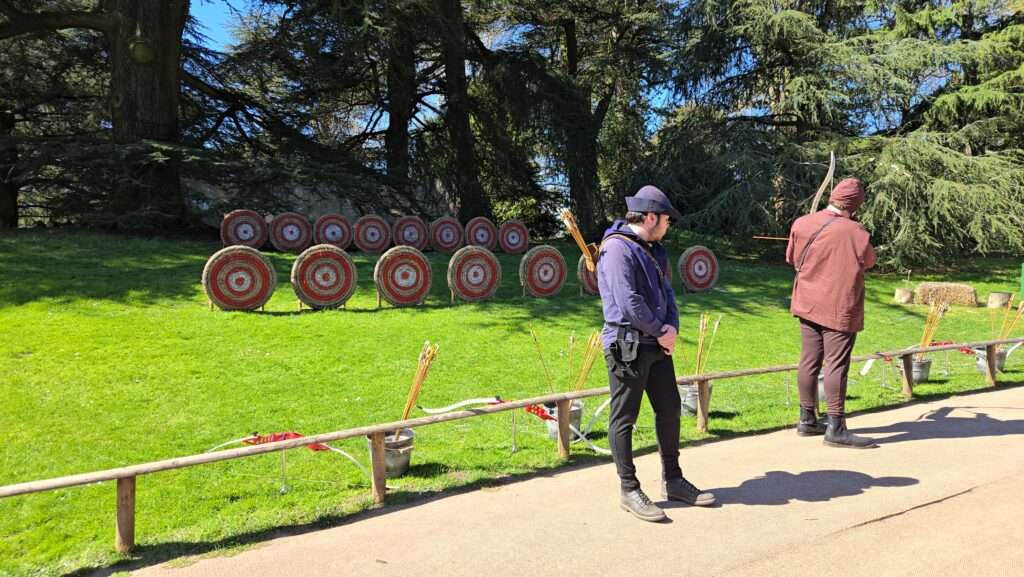
Photo Above: Here you could pay to shoot the targets and try your arm at archery.
Video: Our Day at Warwick Castle
A Riverside Finish
As our energy began to dip, we wandered down toward the river, crossing a soft, grassy knoll that felt like the perfect endnote to the day. The path led us to a peaceful little café overlooking the garden—elegant and serene.
We lingered there for a bit, drawn in by the gentle trickle of a water fountain and the carefully trimmed hedges shaped like birds. It was a calm pocket of the grounds, away from the shows and crowds, and a perfect spot to pause and take it all in.
We sat for a moment, deciding whether we’d seen enough—especially with Stratford-upon-Avon still ahead of us that afternoon. But honestly, it felt like we had. Warwick Castle had delivered more than expected: history and humor, towers and trebuchets, peacocks and peculiar potatoes.
We left feeling full—not from the food, but from the experience.
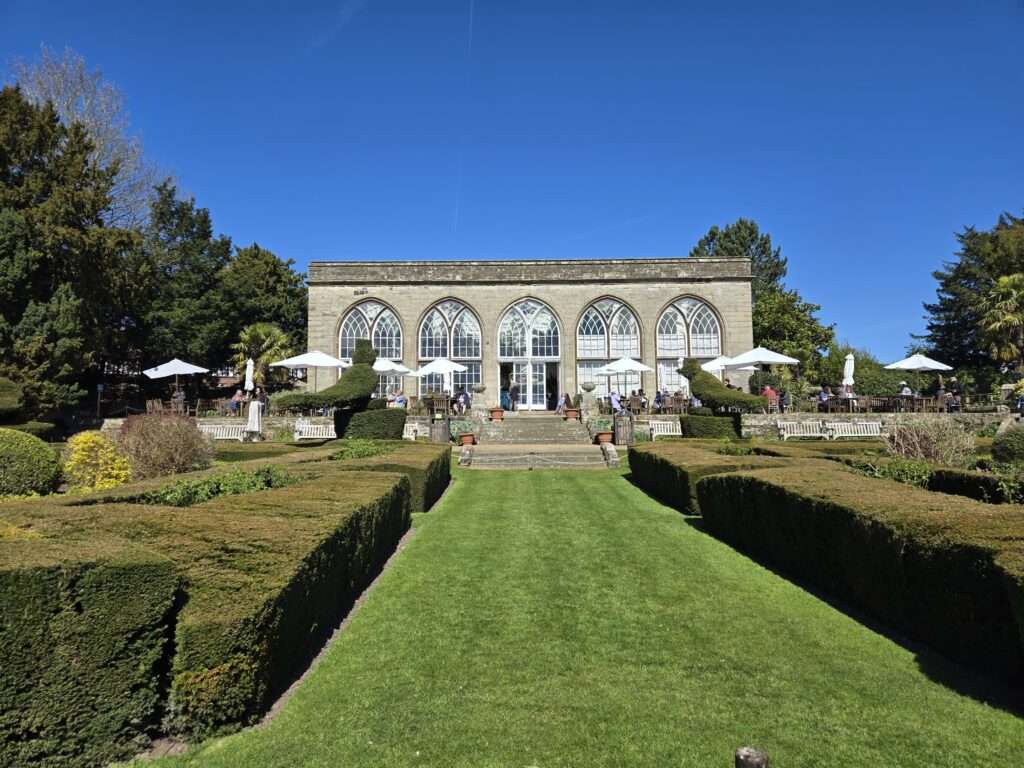
Photo Above: The Conservatory Tea House is a royal treat, at least to see.
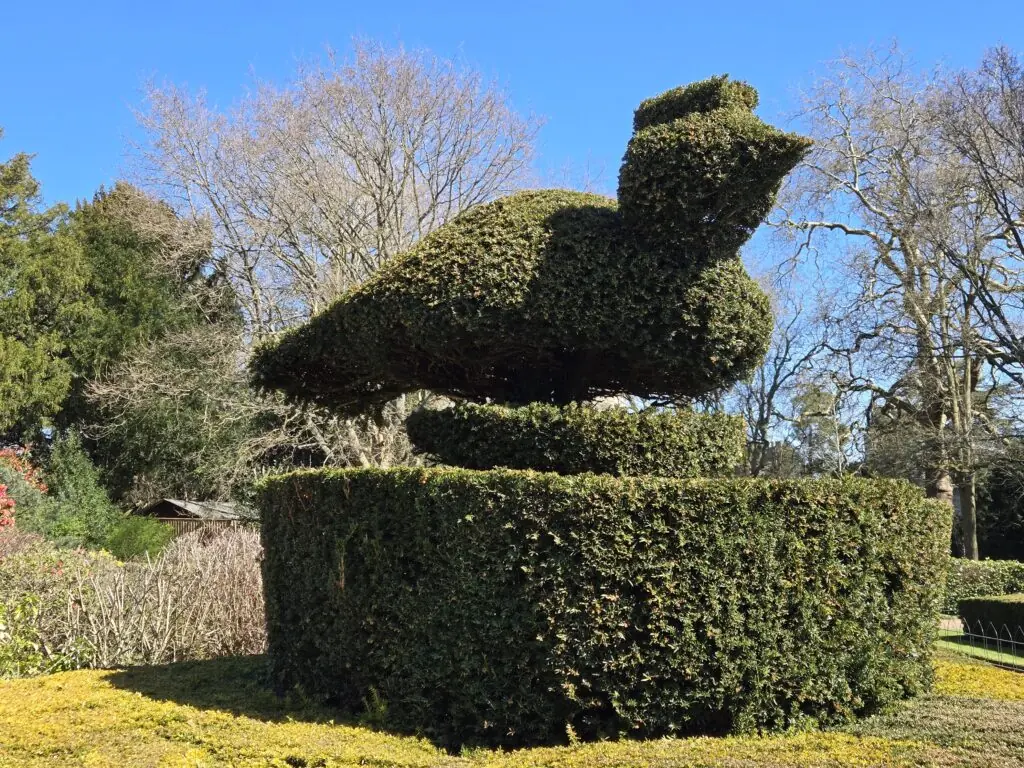
Photo Above: One of the manicured bird hedges.
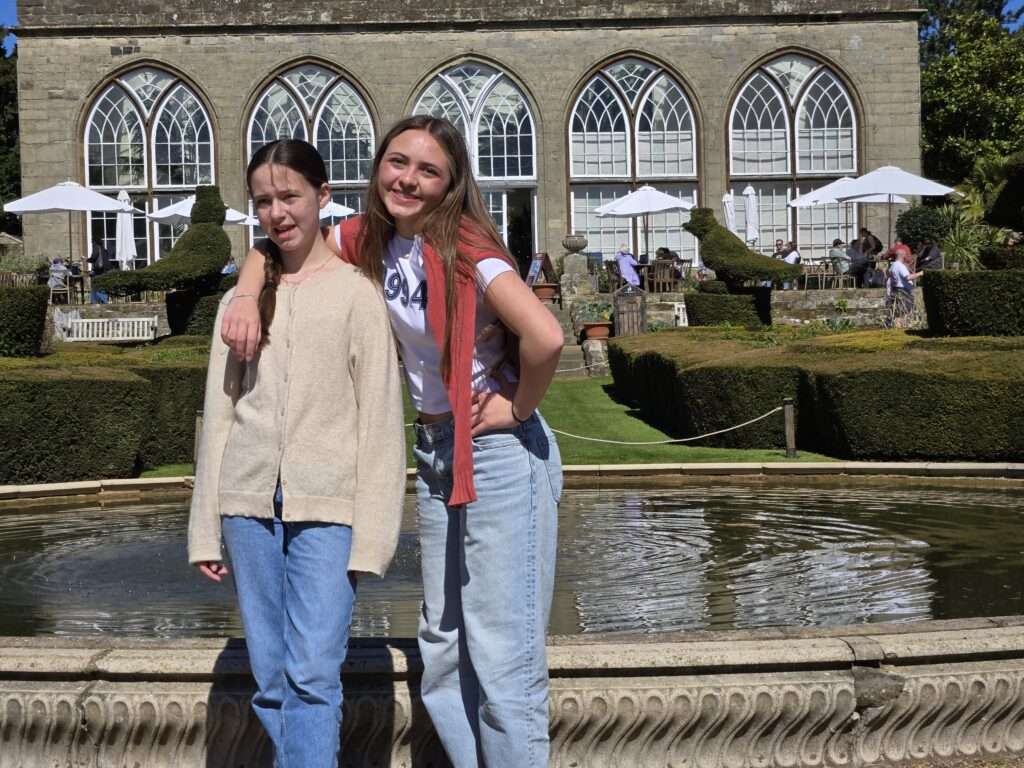
Photo Above: My girls soaking in the gardens and atmosphere.
One Last Note (And a Reason to Return)
Despite having read about Warwick Castle, watched videos, and seen plenty of photos ahead of our visit, I somehow completely missed the Great Hall and State Rooms. Truly—I forgot they were there until we were home. And the funny thing is, I never felt like anything was missing at the time. We had such a full day, so much to explore and enjoy, that I left feeling like we’d experienced it all.
While I’ve visited enough castles (on this trip alone) to guess what those rooms might hold—armor displays, grand fireplaces, velvet ropes—I’m still a little sad we missed them. So here’s my suggestion: if you’re planning a visit, make a quick list of what you don’t want to miss. Warwick Castle is sprawling, and it’s easy to get swept up in what’s right in front of you. A bit of light planning might help you catch everything you’re hoping to see.
That said, even without those grand rooms, this was an absolutely fantastic visit. Worth the time, worth the ticket price, and filled with surprises I wouldn’t trade. The towers, the Time Tower, the maze, the birds of prey, the subtle humor, the immersive history… it all added up to one of the most memorable stops on our trip.
Our visit was nothing short of amazing—and Warwick Castle was a highlight I’d gladly see again (this time with a better lunch plan and a map marked “Great Hall—don’t miss”). Especially after reading what Bramley had to say about it (keep reading if you want to know).

A Fox's Tale: A Quiet Encounter at Warwick Castle
I had meant to find the library.
A fox, after all, will follow his nose to lunch if nothing more pressing presents itself. But as the others queued for something warm in a paper tray, I slipped off—not for mischief this time, but for something quieter. A small library, perhaps. Just enough leather and dust to anchor me.
Instead, I found myself in Warwick’s Great Hall.
I hadn’t meant to linger. I only meant to pass through. But in passing, I felt a shift. Not in temperature, exactly—more like the light adjusting itself without permission. The sort of flicker you don’t spot with your eyes so much as your spine. And you suddenly notice it’s dark.
So I paused, as any creature ought to when the world tilts.
And I remembered a verse—not one of the famous ones, but one I’d come across once, tucked between thicker histories.
Greville’s own words.
In night when colours all to black are cast,
Distinction lost, or gone down with the light;
The eye a watch to inward senses placed,
Not seeing, yet still having powers of sight,
Gives vain alarums to the inward sense,
Where fear stirred up with witty tyranny,
Confounds all powers, and thorough self-offense,
Doth forge and raise impossibility:
Such as in thick depriving darknesses,
Proper reflections of the error be,
And images of self-confusednesses,
Which hurt imaginations only see;
And from this nothing seen, tells news of devils,
Which but expressions be of inward evils.
Greville wrote that long ago. But now it felt oddly present. As if the room were whispering it to me.
That’s the thing about being a fox. You learn to trust what you can’t quite see. The draught that shifts your whiskers. All the parts of a story that go unseen.
Something had changed in the air. I don’t scare easily, but there was a prickle along my spine all the same.
That strange in-between feeling. The sort that comes before a story that’s been waiting a very long while to be heard.
I felt his presence just then.
A memory that hadn’t managed to leave.
I sensed it clinging to the walls. A voice echoing so softly it never quite made its way up and out into the ears of others. Never carried away; instead lingering in the air of the room.
A misremembered life. A closet drama, never to be read, but only sensed.
Fulke Greville. I’d seen his name etched in stone in the quiet chapel nearby:
Servant to Queen Elizabeth. Councillor to King James. Friend to Sir Philip Sidney.
And beneath that, in stark black letters: Trophaeum Peccati. The Trophy of Sin.
A man who rebuilt this place stone by stone. Who served his country, hosted his king, and wrote fiercely, thoughtfully, steadily.
He had lived among giants—Shakespeare, Marlowe, Donne, Sidney himself.
And yet his name survives mostly as a footnote.
His legacy, if remembered at all, is for how he was betrayed—
and how, after a life of careful service, he died a slow and bitterly ironic death:
wounded by his own servant, for leaving him out of his will.
A quiet sort of symmetry, if you believe in that sort of thing.
A betrayal for a betrayal—that returned swiftly enough.
But the legacy he gave to Sidney?
That was never returned.
Only a small portrait hangs here. And beside it, a louder story—the stabbing, the servant, the shame.
That’s what they whisper on the tours.
That’s what they tell the children.
His presence felt stronger. As though it were confirming something—a frustration held tight for centuries.
I never found the library.
But I’d found a story all the same.
One that needed to find its way into an ear,
so it could finally be carried along.
And as I turned to leave,
I rather thought I heard him say—
“You that seek what life is in death…
Now find it air that once was breath.”
So I breathed it in,
just in case he needed someone to carry it out of the Hall.
Perhaps now, at long last, he might find his rest.
If you’d like to spend more time with Greville:
Fulke Greville is a poet for those who think quietly and feel deeply—those who want to see how a man who stood beside Sidney and Elizabeth still questioned everything: ambition, truth, God, even himself. Check out this book on Amazon if you are interested in reading more of his writings, or a window into the mind of the man who built the Great Hall.
P.S. If you’re wondering who I am or how a fox ends up in a castle’s quietest corners, you can read my origin story here. I tend to find my way into places like this.

